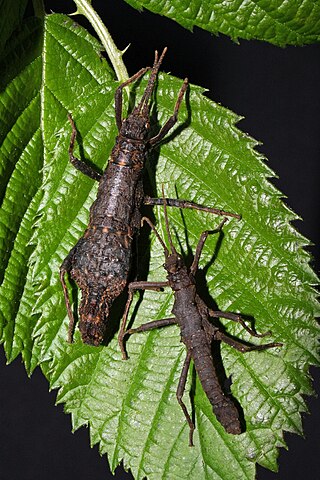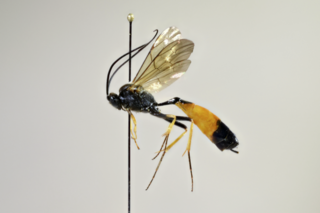
Palaeovespa is an extinct genus of wasp in the Vespidae subfamily Vespinae. The genus currently contains eight species, five from the Priabonian stage Florissant Formation in Colorado, United States two from the middle Eocene Baltic amber deposits of Europe. and one species from the late Paleocene of France.

Cebrionini is a tribe of click beetles from the family Elateridae; formerly ranked as a subfamily or family, they are now considered a tribe within the subfamily Elaterinae.

Megachile campanulae, known as the bellflower resin bee, is a species of bee in the family Megachilidae. Described in 1903, these solitary bees are native to eastern North America. Studies in 2013 placed them among the first insect species to use synthetic materials for making nests. They are considered mason bees, which is a common descriptor of bees in several families, including Megachilidae. Within the genus Megachile, frequently also referred to as leafcutter bees, M. campanulae is a member of the subgenus Chelostomoides, which do not construct nests from cut leaves, but rather from plant resins and other materials. Females lay eggs in nests constructed with individual cell compartments for each egg. Once hatched, the eggs progress through larval stages and subsequently will overwinter as pupae. The bees are susceptible to parasitism from several other bee species, which act as brood parasites. They are medium-sized bees and the female adults are typically larger than the males. They are important pollinators of numerous native plant species throughout their range.
Pristomyrmex tsujii is a species of ant in the genus Pristomyrmex. Known from Fiji, where they are widely distributed but rarely encountered. The species has a discrete ergatoid queen caste that is intermediate between a worker and an alate queen.

Yantaromyrmex is an extinct genus of ants first described in 2013. Members of this genus are in the subfamily Dolichoderinae of the family Formicidae, known from Middle Eocene to Early Oligocene fossils found in Europe. The genus currently contains five described species, Y. constrictus, Y. geinitzi, Y. intermedius, Y. mayrianum and Y. samlandicus. The first specimens were collected in 1868 and studied by Austrian entomologist Gustav Mayr, who originally placed the fossils in other ant genera until the fossils were reviewed and subsequently placed into their own genus. These ants are small, measuring from 4 to 6 mm in length and can be characterized by their trapezoidal shaped head-capsules and oval compound eyes that are located slightly to the rear of the capsules midpoint, with no known ocelli present.
Paraulax queulensis is a species of gall wasp. Biology of Paraulax species is unknown but given they are associated with Nothofagus forests their biology is probably associated with the pteromalid gall community. This species is named after the place where it was first collected, Los Queules National Reserve. P. queulensis closely resembles P. perplexa, bearing common traits such as colour, habitus and several morphological characters. P. queulensis differs by having a more elongate body, which in the female is 4 times longer than it is high; its mesosoma is 1.6 times longer than high, while its metasoma is 1.9 times longer than high. The mesosoma is more dorsoventrally depressed. Its pronotum s 1.5 times longer laterally than high. It possesses longitudinal costulae running from the lateral margin of its pronotal plate to its lateral surface. Its scutellar foveae is discernible even when shallow. The antenna also differs: the pedicel of the female antenna is 1.4 times longer than wide.

Meringopus calescens is a species of wasp belonging to the family Ichneumonidae first described by Johann Ludwig Christian Gravenhorst in 1829.

Holotrichia reynaudi is a species of dung beetle found in South India and Sri Lanka.

Dares murudensis is a relatively small species of stick insect. Like most other members of the genus Dares, the species is native to Borneo.

Sphiximorpha willistoni, or Williston's wasp fly, is a rare species of syrphid fly found in eastern North America. It is a strong wasp mimic. Hoverflies can remain nearly motionless in flight. The adults are also known as flower flies for they are commonly found on flowers, from which they get both energy-giving nectar and protein-rich pollen. Larvae in this genus are found in sap runs of trees.
Spinodares is a monotypic stick insect genus endemic to Borneo, containing Spinodares jenningsi as the only valid species.

Dusona falcator is a large species of parasitic wasp belonging to the family Ichneumonidae, subfamily Campopleginae. It is a parasitoid of the Buff-tip moth. It is one of the largest known species of Camopleginae, able to reach sizes over 20mm. The species can be found throughout the Palearctic realm.
Dusona admontina is a species of parasitic wasp belonging to the family Ichneumonidae, subfamily Campopleginae. It is a parasitoid of the larvae of Herminia grisealis.
Dusona aemula is a species of parasitic wasp belonging to the family Ichneumonidae, subfamily Campopleginae. It is a parasitoid of Geometrid moth larvae, mainly Eupithecia species.
Dusona juvenilis is a species of parasitic wasp belonging to the family Ichneumonidae, subfamily Campopleginae. It is a parasitoid of Eupithecia haworthiata larvae.

Dusona leptogaster is a species of parasitic wasp belonging to the family Ichneumonidae, subfamily Campopleginae. It is a parasitoid of Geometrid moth larvae, the two known hosts being Alsophila aescularia and Lomaspilis marginata.
Dusona nidulator is a species of parasitic wasp belonging to the family Ichneumonidae, subfamily Campopleginae. It is a parasitoid, but the host is unknown.
Dusona terebrator is a species of parasitic wasp belonging to the family Ichneumonidae, subfamily Campopleginae. It is a parasitoid of Noctuid moth larvae.

Callidora is a genus of parasitoid wasps belonging to the family Ichneumonidae and the subfamily Campopleginae. It is relatively species poor, with only five recognized species.
Aiura is a genus of parasitoid wasps belonging to the family Ichneumonidae and the subfamily Campopleginae.










